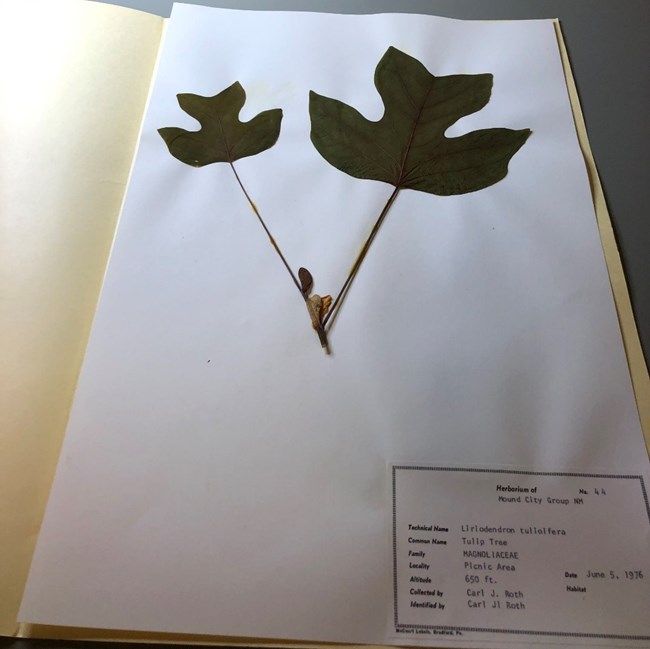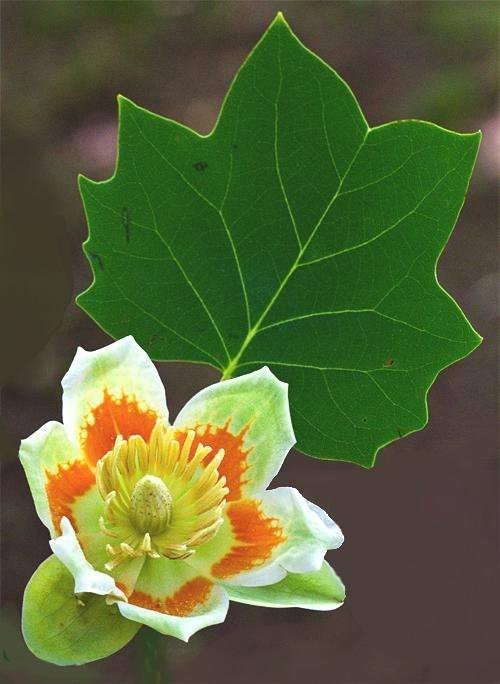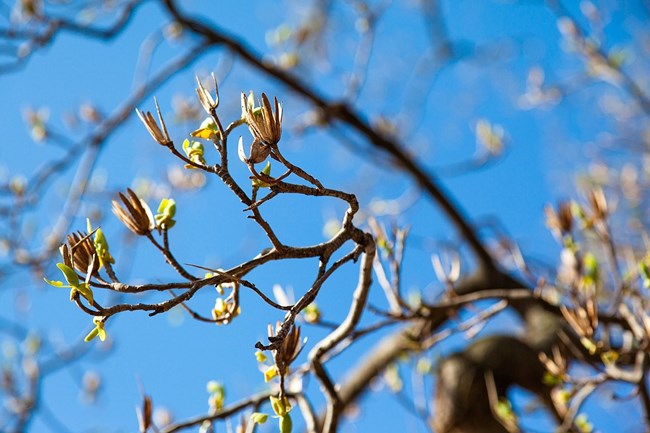Last updated: October 28, 2021
Article
Inside the Collections - HOCU 6162
Hopewell Culture National Historical Park
Tulip Poplar (Liriodendron tulipifera) - HOCU 6162
Written by: Alex Smith, Biological Technician

NPS photo/A.Weiland
HOCU 6162 is a pressing of two leaves from a Liriodendron tulipifera (tulip poplar). These leaves were collected and pressed in 1976 by park employee Carl J Roth. Collected from the picnic area at Mound City Group, this specimen is part of a much larger collection of our park’s natural resources. Mr. Roth set about to collect and identify a specimen of all of the plant species found within our park boundaries. These botanical specimens, along with a collection of reptiles, amphibians, and fish found in the park, are all stored in a climate-controlled room separate from the archeological collection. HOCU 6162 is an excellent example of the unique mitten shaped tulip poplar leaves and the large stipules (leaf-like appendages that form at nodes) that make this species simple to identify.
Natural History of the Tulip Poplar
Lirodendron tulipifera is known by many common names: tulip poplar, yellow poplar, tulip tree, and tulip magnolia to name a few. The tulip poplar is a deciduous softwood angiosperm. Not actually a poplar, the tulip poplar is actually a member of the magnolia family (magnoliaceae). Tulip poplars have alternate, palmately veined leaves. These leaves have four lobes, which may be more or less pronounced depending on the age and canopy arrangement of the branches. The leaf shape is often described as mitten-like or resembling the face of Loony Tunes’ Sylvester the cat. At the nodes, each leaf contains two oval shaped stipules, which surround the twig to form a duck bill shape.
The trunks of tulip poplars are unusually straight and column like, often without any bends or knobs. The bark is smooth to the touch while young but develops deeper white furrows (Figure 1).

wikimedia commons

wikimedia commons

wikimedia commons

wikimedia commons
The tulip poplar has a rich history of cultural uses for both Europeans and Native Americans. The Cherokee tribe has a number of documented cultural uses for tulip poplar. Historically the Cherokee tribe used parts of the tulip poplar tree as medicine to treat parasitic worms, diarrhea, coughs, rheumatism, gastrointestinal distress, fever, and snake bites. Infusions made from bark were also used for poultices and used to treat fractured limbs, boils, and other dermatological problems. Aside from medicine there were a number of other traditional uses. Tulip poplars made excellent lumber, and were used in the construction of houses, furniture, paper, and baskets (Figure 4).
Perhaps the most interesting use of tulip poplar by the Cherokee were for dugout canoes. Due to the long and straight growth habit of the tree, little work had to be done in order to shape the canoe after harvesting the tree. When colonists first arrived to the new world, timber became a valuable resource both for trade with Europe, and for navigating frontier life. Although not as preferable as oaks and hickories for use as lumber there were several qualities that made tulip poplar desirable for crafting. The sheer height and characteristic straightness of the tree means that fewer tools were required to process the wood into long boards and poles. Once cut, the wood is also resistant to warping, and has a uniformly fine grain. The wood is also light and elastic, making it very easy to work into various shapes and sizes. Tulip poplar wood was also desirable to colonials due to its light color making it ideal for painting and staining. The wood was also free of odor making it ideal for crafting containers to store dairy products, lard and other foods that needed to be stored free of external scents to remain fresh. This wood was used heavily for construction, as it could be used for shingles, beams, and joints making it a desirable commercial tree for European colonies. Wood from the tulip poplar was also one of the major woods used for the production of kitchen utensils in the colonies.
Bibliography
Arnoldia Arboretum
1976 Liriodendron tulipifera- Its Early Uses, Electronic document, http://arnoldia.arboretum.harvard.edu/pdf/articles/1976-36-3-liriodendron-tulipifera-its-early-uses.pdf accessed 6/23/20
Missouri Botanical Garden
2020 Liriodendron tulipifera. Website, https://www.missouribotanicalgarden.org/PlantFinder/PlantFinderDetails.aspx?kempercode=a878 accessed 6/18/19
Native American Ethnobotany Database
2020 Liriodendron tulipifera . Database, http://naeb.brit.org/uses/species/2211/ accessed 6/16/20
Natural Resource Conservation Service
2020 Liriodendron tulipifera L. Tuliptree. Website, https://plants.usda.gov/core/profile?symbol=LITU accessed 6/22/20
United States Forest Service
2018 Liriodendron tulipifera. Website, https://www.fs.fed.us/database/feis/plants/tree/lirtul/all.html accessed 6/22/20
Virginia Tech Dendrology
2019 Yellow poplar. Website, https://rb.gy/vdyjgm, Accessed 6/24/20
Arnoldia Arboretum
1976 Liriodendron tulipifera- Its Early Uses, Electronic document, http://arnoldia.arboretum.harvard.edu/pdf/articles/1976-36-3-liriodendron-tulipifera-its-early-uses.pdf accessed 6/23/20
Missouri Botanical Garden
2020 Liriodendron tulipifera. Website, https://www.missouribotanicalgarden.org/PlantFinder/PlantFinderDetails.aspx?kempercode=a878 accessed 6/18/19
Native American Ethnobotany Database
2020 Liriodendron tulipifera . Database, http://naeb.brit.org/uses/species/2211/ accessed 6/16/20
Natural Resource Conservation Service
2020 Liriodendron tulipifera L. Tuliptree. Website, https://plants.usda.gov/core/profile?symbol=LITU accessed 6/22/20
United States Forest Service
2018 Liriodendron tulipifera. Website, https://www.fs.fed.us/database/feis/plants/tree/lirtul/all.html accessed 6/22/20
Virginia Tech Dendrology
2019 Yellow poplar. Website, https://rb.gy/vdyjgm, Accessed 6/24/20
